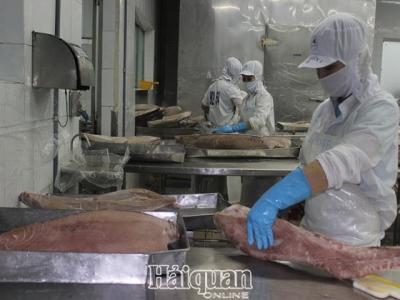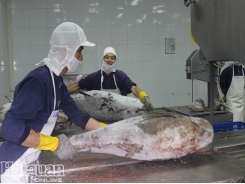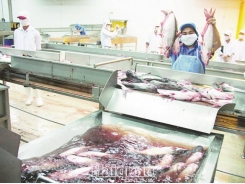Export of many key fishery products decreased

In the first nine months of 2019, the country's seafood export is estimated at nearly US$6.3 billion, down slightly by 0.8% over the same period last year. In particular, except for tuna, which still increased by 20%, the export of key products decreased.
Tuna exports increased sharply in the past 9 months. Photo: T.H
Export of shrimp continues to decline
According to the Vietnam Association of Seafood Exporters and Producers (VASEP), due to the increasing supply and low export prices, the shrimp export turnover in the first nine months of 2019 decreased by 7% over the same period last year. Accordingly, in the first half of the year, shrimp production increased, raw shrimp prices decreased, while the inventory of shrimp was high, the supply of shrimp from other countries also increased, so prices of imported shrimp were lower than last year andshrimp exports continued their downward trend from 2018.Exports decreasedmainly due to poorresults of first half export, from July, exports showed signs of gradual recovery.
Exports to major markets such as the EU, Japan, Korea, and ASEAN all decreased, while they increased slightly to other markets such as China, the US and Australia.
Exports to the EU still grew by 19%, of which exports to major consuming countries such as the United Kingdom, Germany and the Netherlands all decreased, the average price of shrimp exports in these markets decreased by US$1 per kg over 2018.
In the Japanese market, although the export volume was stable and the demand of the market did not increase, the average export price decreased by US$1 per kg, from US$12to US$11, causingthe export value tofall in this market.Meanwhile, shrimp prices from Thailand and Indonesia were stable at US$11 per kg, Indian shrimp prices fell slightly to US$9.3 per kg.
Thanks to a sharp increase in exports from July, shrimp exports into the US market in the past 9 months increased by 3% over the same period last year, after a continuous decrease in the first 6 months due to high inventories.
According to VASEP's forecast, in the last months of the year, shrimp exports tend to be more positive tothe US, China and Japan markets in the second half of the year when inventories decrease, demand increases and shrimp production in Indiais forecasted to decrease by 20-30% due to the weather and the price reduction.In addition, Vietnamese enterprises may havegraspedthe situation and adjusted export plans forChinese markets.However, competition on shrimp prices still causespressure for shrimp exporters in the last months of the year. It is forecasted that shrimp exports in 2019will reach US$3.4 billion,down 4% compared to 2018.
Excess supply, falling prices
Like shrimp, the main export item of pangasius decreased by more than 8% in the first 9 months of 2019 due to excess supply, causing the export price to fall.
According to VASEP's analysis, pangasius production increased from 2018 and early 2019, leading to an oversupply, some shrimp farmers facing difficultiesswitched to pangasius, leading to lower raw material and decrease of export pricesrecently.
Pangasius exports into the US market dropped sharply by 40% to US$221 million, due to the high anti-dumping tax during the POR14 period. According to the final result of anti-dumping tax on frozen pangasiusfilletsexportedfrom Vietnam to the US in the 14th review from August 1, 2016 to July 31, 2017, the final tax rate published in April 2019 is much higher than the preliminary results published in September 2018.
After the above results, pangasius exports into the US market continuously decreased. Vietnam has 62 pangasius enterprises qualified to export to the US but most of them cannot export because of high anti-dumping tax. In recent years, only a few enterprises, such as Vinh Hoan, East Sea, are not subject to anti-dumping tax or low tax rates and can export to the US.These are big pangasius enterprises accounting for a high proportion ofVietnam's pangasius export structure.
Except for exports to China on strong recovery momentum, which was up 71% in July and continued to rise sharply in August, exports to other markets all reversed. Export growth to the EU after 9 months slowed compared to the first 6 months, only up 7%, exports into ASEAN increased by nearly 1%, exports into Mexico increased by nearly 6%.
Leading pangasius import markets, China has outstripped the US and EU. Previously, Vietnam only exported whole pangasius to some southern border provinces of China,but now pangasius fillet products are available in big cities such as Beijing, Shanghai and Dalian. It is forecasted that Chinese demand will be even higher.
Pangasius exports into China in the first months of the year were affected by the tightening of border trade and quality control.However, since June, it has rebounded and the following months, export enterprises as well as Chinese importers have caught up to the requirements and madebetter adjustments, so exports will continue to increasestrongly in the second half of the year.
With high anti-dumping tax rates, a few Vietnamese pangasius export companies can penetratethe US market, although tax risks are still a barrier that even these enterprises have toexpandto other markets.Therefore, exports to the US in the second half of the year are unlikely to recover. It is forecasted that pangasius export in the whole year of 2019 reached US$2.23 billion,down 3% compared to 2018.
With the results of each key product, the total seafood export turnover in 2019 will reach US$8.9 million, up 1.4% compared to 2018.
Related news
Tools

Phối trộn thức ăn chăn nuôi

Pha dung dịch thủy canh

Định mức cho tôm ăn

Phối trộn phân bón NPK

Xác định tỷ lệ tôm sống

Chuyển đổi đơn vị phân bón

Xác định công suất sục khí

Chuyển đổi đơn vị tôm

Tính diện tích nhà kính

Tính thể tích ao




 Three more kinds of Vietnamese seafood exported to…
Three more kinds of Vietnamese seafood exported to…  Exports of seafood unlikely to reach $10 billion
Exports of seafood unlikely to reach $10 billion